Text
Week 13 | Final Presentation + Submission

PROCESS + REFLECTION
This week we focused on tweaking the logistics of our proposal and how this work would become fully realised. Through reiterating and refining our proposal we've been able to really polish the work and the proposal ready for submission. Our in class presentation was a great opportunity for feedback and to find the kinks in our propsal.
In reflection towards submission I believe I need to rework the power point to be more professional. While this task has been kind of tedious, it has been probably been the most beneficial part of this unit because I will learn more about proposing for anything from grants applications to exhibitions, something I've been uncertain of in the past. It's a real world skill that will benefit my broader practice relative to the industry. While spatial installation is not my forte, I've genuinely enjoyed this assessment even though it's left me stumped and stressed many times. I'm happy with our artwork proposal, though I think in reality it needs more depth of research, planning, budgeting, and importantly consultation with the indigenous community to really ace the brief. It's definitely rushed but it's not too bad for a first go, especially being a group work assessment!
DOCUMENTATION

ARTIST RESEARCH

BRISBANE SIGN
The Brisbane Sign was created for the G20 Leaders Summit Conference in 2014. I can't find much about who was the project leader or any artists who made it. Though the original sign was built and painted by the organisations below, and the letter shapes were design by past QUT student Aaron Couples (Hinchliffe, 2014).
(B) - Built by: Ridley Road Queensland Men’s Shed; Decorated by: Queensland Pride Festival
(R) - Built by: Pine Rivers Queensland Men’s Shed; Decorated by: Brisbane Youth Service
(I) - Built by: Labrador Queensland Men’s Shed; Decorated by: Amnesty International(QLD chapter)
(S) - Built by: Shed West; Decorated by: Griffith Uni Contemporary Australian Indigenous Art Group
(B) - Built by: Buderim Queensland Men’s Shed; Decorated by: Multicap Association
(A) - Built by: Carina Queensland Men’s Shed; Decorated by: Multicultural Development Association of Queensland
(N) - Built by: Alexandra Hills Queensland Men’s Shed; Decorated by: Queensland Children’s week
(E) - Built by: Mt Gravatt Queensland Men’s Shed; Decorated by: Queensland Country Women’s Association
This sign is not only iconic and a great tourist attraction, it engaged the broader community to complete the project. That perfectly situates the work as a vibrant symbol of diversity (Queensland Government, n. d.). This sign has been crucially informing in the process of finalising our proposal. With the direction we were heading, this gave us the key to making the sculpture feel like a part of Brisbane rather than our own ideas that may just impose the site. Community engagement will be a perfect way to make the work feel like it belongs to Brisbane.
REFERENCES
0 notes
Text
Week 12 | Refining + Material Experimentation

PROCESS + REFLECTION
This I continued my material experimentation using the laser cutter. I created my print with 1.8mm grey card, making sure I had the resources to mess around freely.
I got my cut outs and started constructing different shapes, negating the kinetic and resolved material elements, purely thinking about form, layered planar surfaces and proportion. I tried a few different combinations, using skewers to connect the parts. It reminded me of making Bionicle's as a kid.
I stumbled across the basis of our final work after reducing the amount of waterway cutouts and just playing with the Brisbane river shape. I turned it on an axis and found that it did perfectly resemble a snakes form. I constructed the module and discussed a change of plans to Laura without a kinetic element. As I was creating this I felt that the additional kinetic and wind components were muddying the work conceptually and visually. It was too much so I felt we needed to refine and simplify the work to really focus on the pertinent aspect of the waterways. This has been inspired by my recent artist research.
I started thinking about how this 'brown snake' structure would interact with the site, the visitors and how the council would hypothetically receive it. I found myself inspired by the Brisbane sign at South Bank and Watermark (R, Tipping. 2004) at New Farm. I can really visualise the sculpture having an iconic presence on top of Barrambin with a refined focus on the recovery and connection to country. I think this conceptual direction further resolves the subversive message of reconciliation we're intending.
We created mock-ups and strengthened our research in preparation for the final presentation in week 13. We are now thinking to engage the broader artistic and marginalised communities in Brisbane to build and paint the work. I think through our iterative and experimental process we were able to refine our a hypothetical work. We allowed ourselves not to become attached to elements that didn't support the concept. Next week we need to work out the logistics and how this would be realised, I'm glad that we were able to manage our delays in the process and break out of the rigid goals we set ourselves.
DOCUMENTATION








RESEARCH

RICHARD TIPPING
Richard Tipping in an Australian artist and poet whose work is situated in the power of words, often tapping in to the common dialect between language and art (Art Gallery of NSW, n. d). Tipping's practice is comprised of many mediums all involving text, his most notable series being his roadsigned series. Watermark (Tipping, 2000) is an example of Tipping's work in New Farm, Brisbane, that adorns the view of the river bend. The work is a reference to the devastating 1893 and 1974 floods, the work has now witnessed the 2011 and 2022 floods. The letters literally appear as if they are underwater, while seeing letters in a sculptural form comments on the weight of words, and how speaking them 'concretes' thought (Tipping, n. d). Tipping's sculpture feels persistently relevant with the current climate crisis, and is a constant reminder of the problems Brisbane would face in future with more flooding. This work has been directly informative in terms of site specificity and the way the public interacts with it.

SAM CRANSTOUN
Sam Cranstoun is an Australian artist who graduated from QUT in 2010. His work has evolved over the years, he was an Archibald Prize winner for his incredibly realistic portraits and has since translated his work into many medium including conceptual installations and text based work. Cranstoun's practice questioning systems of representation and how images, pop culture and mass media influences how history is shaped (Gralton, n. d.). Cranstoun's text-based public sculpture Utopia (2019) does just that through language, colour and form. The sculpture draws parallels between fact and fantasy, referencing Ken Done's AUSTRALIA sign (created for the Brisbane World Expo 1988) that became synonymous with Australia's depiction as a modern day paradise (The National 4 Australian Art Now, n. d.). Again, this work inspires me with it's subversive questioning of Australia as 'the lucky country', the bright colours contrast with dark historical events that have taken place here. As with Tipping's Watermark, this piece is monumental and simple as I have aspired with The Brown Snake.
REFERENCES
0 notes
Text
Week 11 | Budgets
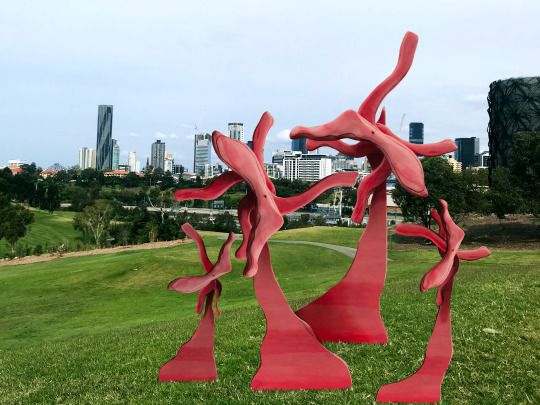
PROCESS + REFLECTION
We didn't get to budget this week, as we had planned to start our material experimentation. I brought in sticks I collected from my yard, we peeled the bark off while discussing our work. We had another helpful consultation from Genine who told us not to think of the logistics and budget because it was limiting our creativity and experimentation.
We sanded the sticks and compiled them together to make a kind of stick pinwheel - without worrying about the shapes to much. Our challenge was how to make this spin without human intervention as there was no mechanism catching the wind. Aside from being flimsy, it was not very visually outstanding so this put a halt on our plan to use sticks. The next idea was to sand plywood into basic waterway shapes, based off the drawing. I had done this before, last year I sanded plywood into organic shapes as a base to paint portraits on for my grad show. I began drawing the shapes onto recycled plywood. Then started using the big jigsaw before relocating to the small one to cut the tighter curves. From their I used the electric rotary sander to carve out the shapes. We both hand sanded them down to get them super smooth and Laura started constructing it into some kind of structure.
We decided to play around in photoshop, I tried out multiplying the structure at different sizes playing with proportion, scale, rhythm, and interval. I tried different colours and configurations to see how this could transform the work. The photoshop experiments worked well but I felt I want to try using the laser cutters at GP so I can get the exact shapes I want and play more.
To reflect, I think it's obvious how much we were limiting ourselves by not actually creating anything with out hands. It's a much healthier and efficient process to actually feel the material to understand it's properties and limitations. The plasticity of photoshop allowed us to take our experimentation further. While we're late to the game I think we have made great progress, though I suspect that we're going to need to do lots of refining and further playing with this work before it's finalised, it's getting a little muddy at the moment.
DOCUMENTATION

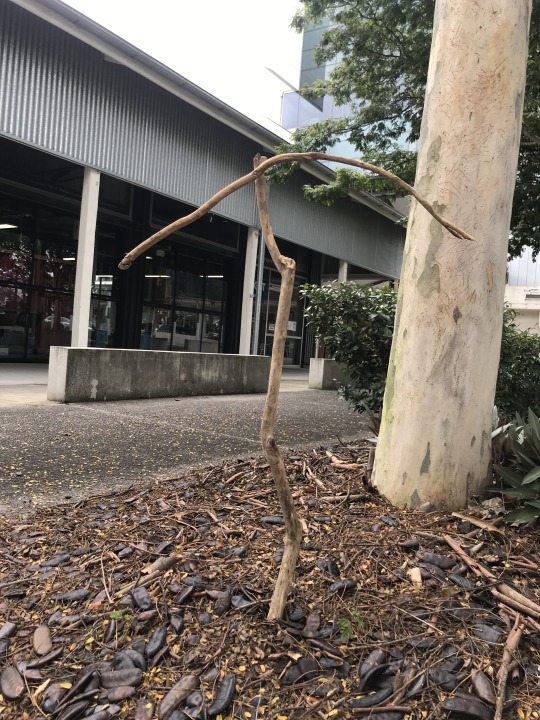

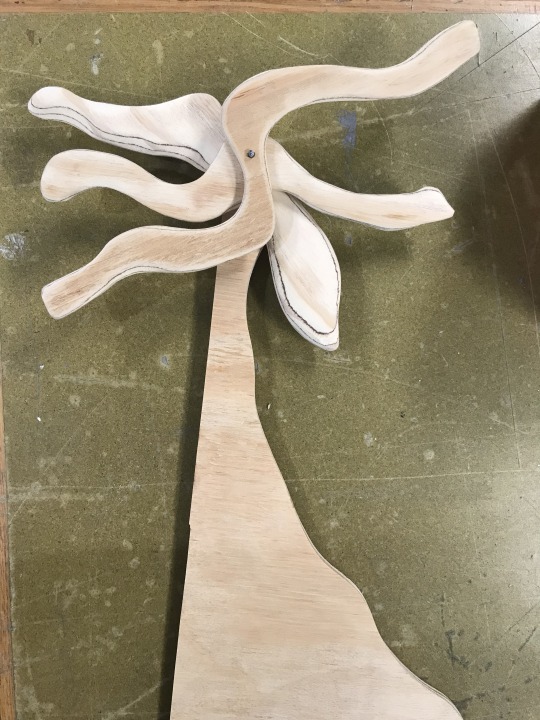



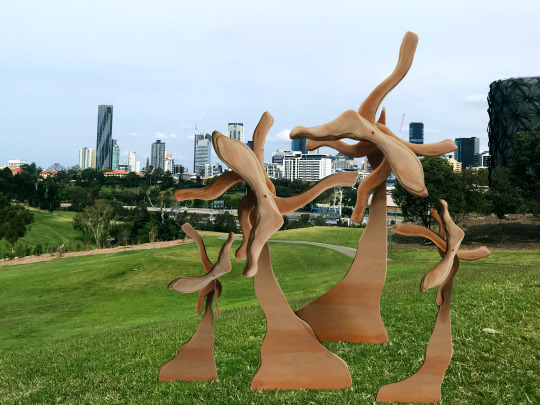

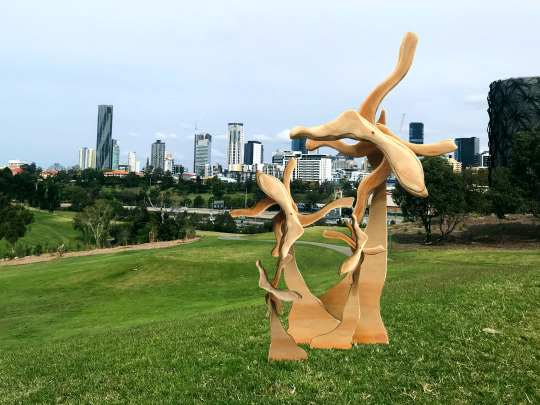
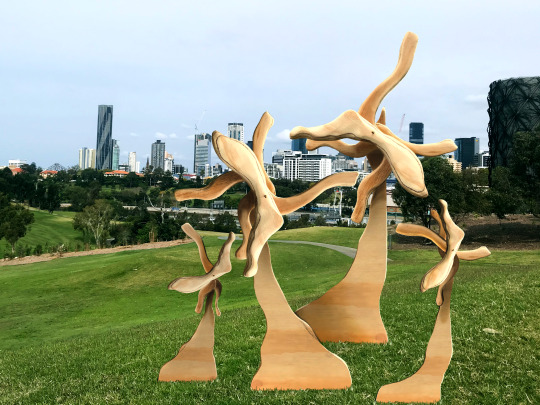


RESEARCH
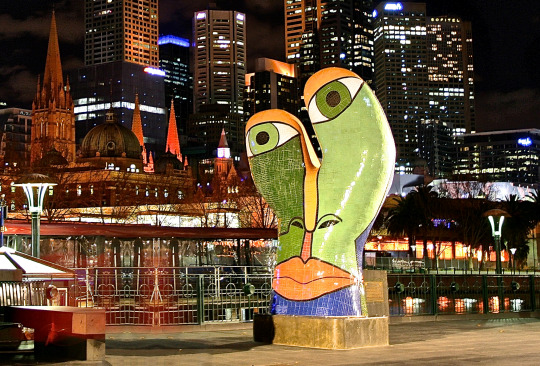
DEBORAH HALPERN
Deborah Halpern is a multi-disciplinary Melbourne based artist working with ceramics, sculpture, print making and paint blowing. Halpern has established herself as a well respected member of the arts community with her beloved public sculptures found around the city of Melbourne (Arthouse Gallery, n. d). Her sculptures in the 80's and 90's became the 'face' of Melbourne's tourism industry and are revered as part of the identity of Melbourne (Cowie, 2021). One of her most famous works Ophelia (Halpern, 1992) resides at Southbank, it's unique form and colourful mosaic tiles on such a grand scale create mass, form and proportion. Halpern's work is inspired from many things including poetry, music, nature, architecture and more; Ophelia being drawn from Hamlet. Halpern wanted to create Ophelia as a work for everyone, not just artists to enjoy and identify with (La Terra, 2018). Aside from the vibrant and whimsical beauty observed in Halpen's work, I like the angle the artist has taken with her public sculptures to include all viewers and engage the broader 'mosaic' of Melbourne. This aspect is specifically informative for my project. The grand scales and colour that the artist works with enhances the site, I hope to be able to create the same gestalt with our work.

SUSAN HEWITT + PENELOPE LEE
Artists Susan Hewitt and Penelope Lee collaborated to create another beloved public sculpture in Melbourne, Great Petition (2008). The huge sculpture is fabricated from steel, embodying a linear movement, literally looking like a large scroll of paper coming undone. The sculpture was petitioned by the Victorian Government and is a homage to the 260 m petition signed by women to prove that they did, in fact want the right to vote. The structure is a grandiose symbol of women's suffrage, determination and collective effort to create change (Culture Victoria, n. d). I find this sculpture to have the same sense of scale an curious impact that Halpern's work does. While much more expensive and ambitious in scale than we are able to achieve with our proposal, this work has again inspired me to think toward simplistic symbolism and scale with out work. This video also is a great insight into the logistics that go behind a project like this.
youtube
REFERENCES
0 notes
Text
Week 10 | Refining, Reflecting + Research

PROCESS + REFLECTION
This week we reconvened at the art studios and discussed where we were at after a little hiatus. We changed idea and notes and have settled on sketches of what we're going to try make. We have visualised a hypothetic kinetic stick sculpture based off a pin wheel. We plan to collect sticks from the site and sand them into shapes based off the water ways. They won't perfectly resemble them but they will add their own organic visual input. We had a consultation with Genine who showed us an installation she thought of when looking at our concept, she encouraged us to think less about a final out come, and how it's a very 'colonial' way of thinking to think of an end goal rather than the 'indigenous' perspective of process and playing. We didn't start our material play today (again we're far behind) but we did give ourselves a frame work to play on. So we came out of today pretty open minded and realised that we were limiting ourselves by not actually getting into the workshop yet. Spatial work is an unfamiliar medium to me to I neglected the enjoyment of process. So next we will be in the workshop for a few hours to begin material play.
DOCUMENTATION




RESEARCH
K-STUDIO

K Studio. (2011). Barbouni [kinetic roof installation]. Pilos, Greece. https://www.k-studio.gr/project/barbouni/
K-Studio is a unique design studio that merges tradition with contemporary architecture and fine art. This installation was created for Barbouni, a restaurant in Greece that is part of luxury resort Romanis Costa Navarino. "The animated ceiling resembles the waves on the beach and offers a rhythm to the restaurant, just like breathing" (K Studio, 2011). The installation is also functional, designed to ventilate the space and create shade while inspiring a multi-sensory, immersive experience. I came across this design after a recommendation from my substitute tutor who felt our concepts and sketches had a fluidity that may not be achieved from our material choices. She guided us to experiment with different materials that could further channel into my research on waterways but also to focus on the process. This helped Laura and I to stay open about our work and let things flow naturally.
FIONA FOLEY

Foley, F. (2005). Witnessing to Silence [cast bronze lotus lilies that, stainless steel columns embedded with ash in laminated glass panels, and granite pavers]. Brisbane, Australia. https://www.uapcompany.com/projects/witnessing-to-silence
Another great recommendation from our tutor, who advised us that our work could incorporate a subversive message. She guided us to think about how we don't necessarily have to follow the crowd and to break the rules (a little). Fiona Foley is an Australian first nations (Badtjala) artist. She has a phenomenally extensive career that works to dismantle historical stereotypes through photography, sculpture, installation and more (Loxely, n. d). We specifically looked at Foley's site specific sculptures Witnessing to Silence (Foley, 2005) that are placed in front of the Brisbane Magistrates Court on Roma St. The works were proposed to the council as a work that commented on the eternal forces of nature and how that governs human life, symbolic of the extreme flood and fire disasters in Australia (Brismania, 2015). However after they were erected it was revealed that the works were in truth memorials to conflict between white settlers and indigenous people, noting locations where the massacres occurred and symbolic of how the bodies were disposed of (UAP, n. d). This work becomes powerful in relation to its site, being in front of the court, evoking a form of justice that was never brought through the system.
REFERENCES
0 notes
Text
Week 9 | Work in Progress Presentations

PROCESS + REFLECTION
This week Laura and I couldn't make class due to sickness and to be completely honest; deficiency of time management on my part. We have been behind the weekly schedule and have not had any progression for our proposal since week 8. So I took this opportunity to return to the site to strengthen our conceptual basis for the work.
I wanted to return to the site on my own, I have a habit of avoidance of attendance when it comes to class because I generally like thinking and working on my own. I wanted to experience the site solo as I felt I might connect to country better.
I took more photos of the site and reflected on our idea to do a hanging installation. Site one doesn't have many trees but it does champion many great flat spots overlooking the view, it would be a shame not to utilise this. I think we need to work with our site rather than against it. Nothing beats that view and I can't get it out of my mind do create something that interacts with that. There is a decent amount of wind up the top of the hill. This suits a kinetic sculpture. I'm leaning towards a pinwheel mechanism over a hanging structure and will have to discuss this with Laura.
In my research I looked at the Victoria Park history document and lectures 7.1 through to 7.3. Throughout conversations of what Barrambin used to be and what the Council is trying to recover, I found the most recurring theme the lost waterways. I drew shapes based off early maps of waterways found in the Victoria Park Summary (Kerkhove, 2020) from the BB learning materials. Creating something wind activated that focuses on the sites relationship to waterway is the path my research is leading me down. I also found out that the Brisbane river used to clear and swimmable, vastly different to the chocolate milk colour it is today. This has an adjacent dialect to the evolving ecological landscape of Barrambin and the greater Brisbane area happening today. This concept has much more breadth and depth of research, I actually feel like I've learnt something.
DOCUMENTATION



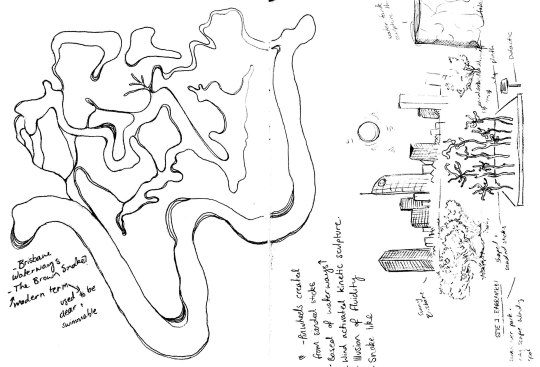




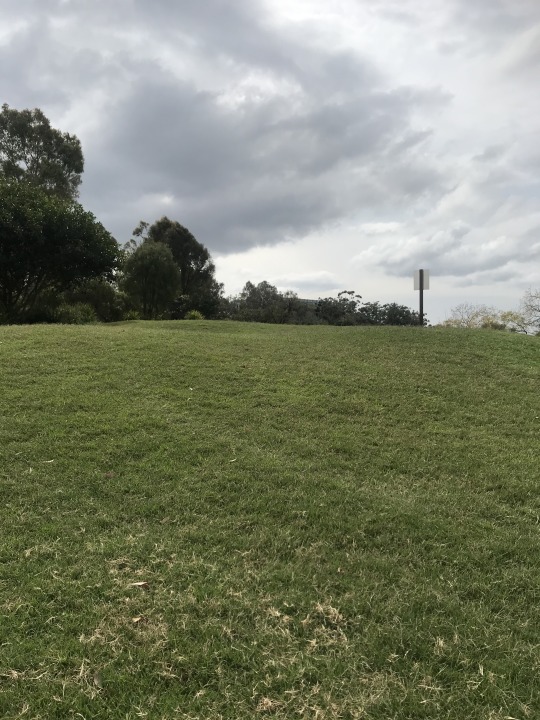
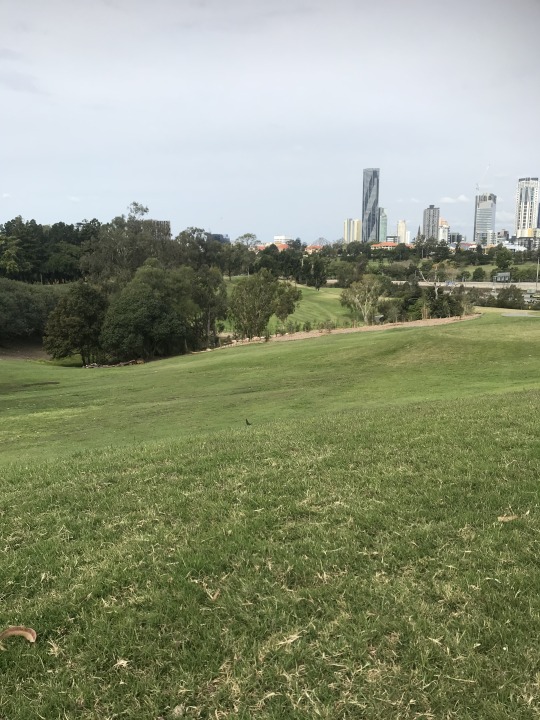



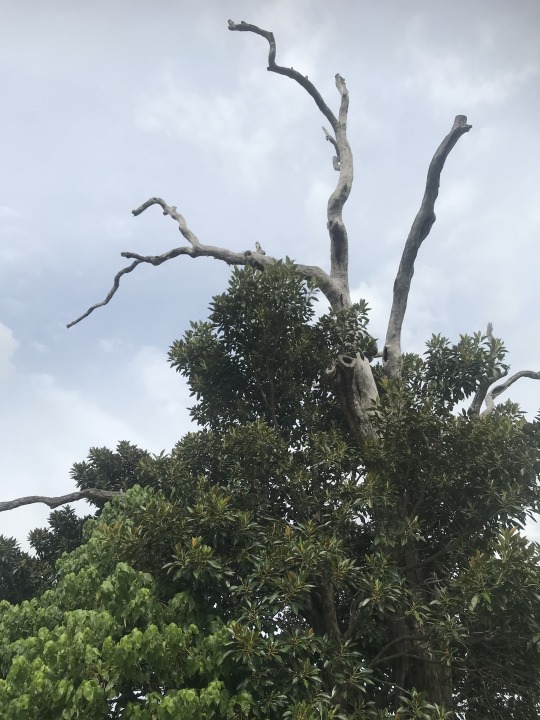

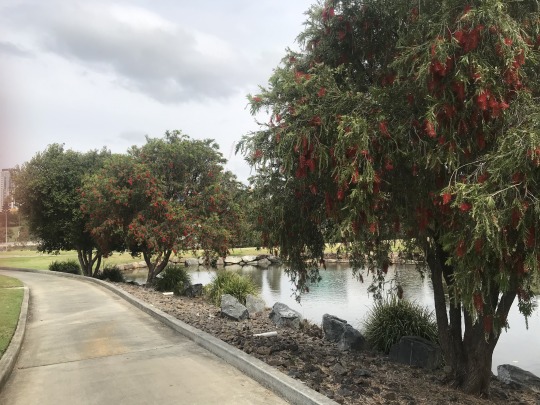


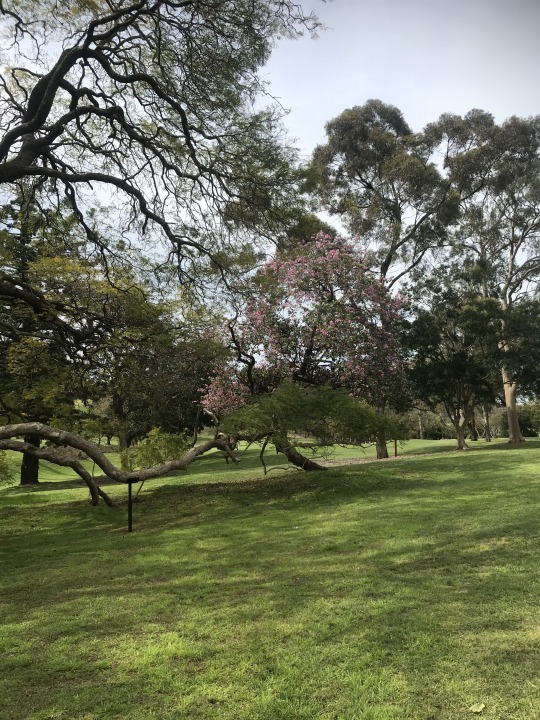
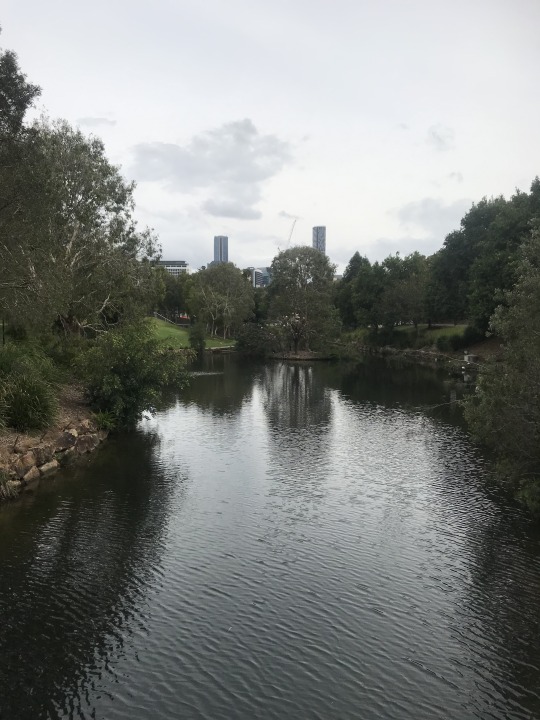

RESEARCH

Goldworthy, A. (1986). Woven Branch Arch [ephemeral branch sculpture]. Langholm, Dumfriesshire, Scotland. https://www.pinterest.com.au/pin/354658539376150080/
ANDY GOLDSWORTHY
Andy Goldsworthy is English artist most known for his ephemeral site specific land art, where he takes materials from the site and leaves the work to be reclaimed by nature (Newcastle Art, n. d). Goldsworthy's practice is broad and driven by the properties of the site, integrating with it rather than imposing on it. Goldworthy's material choices reflect what Laura and I would like for our own proposal. Barrambin offers sticks, leaves, timber and bamboo however our challenge will be our lack of knowledge for the naturalistic materials.
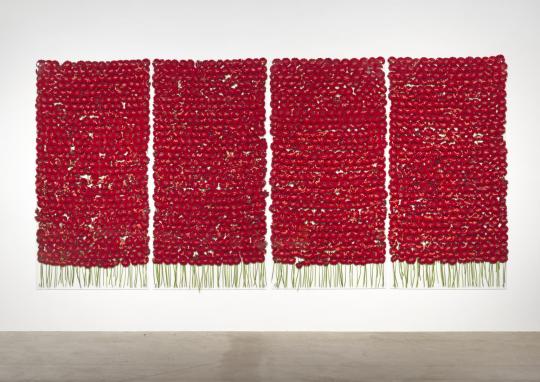
Gallaccio, A. (1991-2003). Preserve Beauty [large scale flower and glass panel installation]. Lehmann Maupin Gallery, New York, USA. https://www.tate.org.uk/art/artworks/gallaccio-preserve-beauty-t11829
ANYA GALLACCIO
Anya Gallaccio much like Goldworthy creates site specific installations using organic matter, however focuses on the process of decay of these materials in the gallery context (Douglas, 2018). Her work Preserve Beauty (1991-2003) is a large scale installation that showcases red 'beauty' flowers, hung behind 4 large glass panels and were left to decompose in the gallery. This work references traditionally feminine flower arranging practices while commenting on the fleeting and commodified nature of beauty (Anderson, 2014). I admire the way Gallaccio uses simple organic materials with such symbolic intention. This inspires me to conceptualise a work that has careful symbolic correlations to material and/or site.
REFERENCES
R, Kerkhove. (2020). KVB222: Spatial Art: Object & Site. Victoria Park Summary. https://blackboard.qut.edu.au/bbcswebdav/pid-10116741-dt-content-rid-58666643_1/courses/KVB222_22se2/Victoria%20Park%20Area%20Summary.pdf
0 notes
Text
Week 8 | Development

PROCESS + REFLECTION
This week my partner and I started brainstorming our ideas as we were allocated site 1. At the end of class we had to casually present our initial ideas for feedback.
We discussed what we both resonated with, finding we both were thinking along the lines of kinetic sculpture. We thought conceptually we could work with Barrambin meaning 'windy place' in Indigenous language. We started sketching and discussing materials that might best suit the project - focusing on minimum environmental impact and organic materials taken from the site that could be potentially returned. To surmise, these are some dot points on our thoughts and ideas
Kinetic sculpture on site 1 - potentially something that cascades down the hill or is situated in the newly planted trees.
Kinetic motion created from wind - maybe something that hangs in the trees (newly planted patch or some of the surrounding patches on site 1 if any)
Hanging installation based off wind chimes OR based of a pinwheel mechanism.
Organic matter from the site including sticks, branches, flowers, bamboo and bark.
Fallen sticks and leaves were used as firewood and kindling for indigenous people to create fires.
Recycled materials? Reverse Garbage in Wollongabba
Kinetic movement has the potential to create soundscapes
Soundscape that imitates the sounds of the park
Organic shapes based off local wildlife like birds
WIND - SOUND - MOVEMENT - NATURAL - ORGANIC - LARGE - MULTIPLIED
When we presented the idea, we found that it was very similar to many other groups and through our discussion we found that the newly planted trees would not be fully grown in the time period. The challenges that were introduced were how we would create a hanging installation with a site that has lots of open space. Then how is our proposal going to differ from that of other groups. Finally the WHY was missing from our idea. WHY should this exist and how does it speak to the space. Our initial ideas need will need to provoke a lot more research and thought, though at least we started talking about it and getting the cogs ticking. It was beneficial to be able to verbalise our plans with the class so we could get an idea of how it would be received. At least we can dig deeper now, iterate out ideas and start researching in the right direction and find what will be actually enhance our site.
DOCUMENTATION








ABOVE | Images we downloaded off the internet (Pinterest) of garden pinwheels and wind chimes for inspiration. We were leaning more towards the wind chime side of things.


ABOVE | My initial sketches, and brainstorming
RESEARCH

ALEXANDER KNOX
Alexander Knox is a Melbourne born and based sculptural installation artist who graduated his Graduate Diploma of Fine Art (Public Art) at RMIT in 2003 (Knox, n. d). Knox specialises in monumental kinetic light installations that can be found around Melbourne and other cities in Australia, including Brisbane (Ten Cubed, n. d). I came across Knox earlier in the semester after watching a lecture and am mesmerised by his practice and folio of work. Triforms (Knox, 2020) is a kinetic light sculpture installed at St Kilda Road in Melbourne. This work is elusive with little written about it, having never seen it in person I can only be astonished by the sophisticated multiple, organic forms through the screen. The cylindrical forms create a sense of physicality, due to mass and negative volume. The forms resemble wasp nests, Knox is known for taking inspiration from the natural world (UAP, n. d). While a different direction in terms of material, the idea of organic forms that reference nature and the site is something Laura and I have discussed with our own proposal.

ANA MENDIETA
Ana Mendieta (1948-1985) was a multi-faceted Cuban artist who was renowned for her performative, ephemeral, conceptual works; most notably her Siluetas Series (Mendieta, 1973-1978) (The Art Story, n. d). Mendieta's work focused on the intrinsic relationship between the body, nature, and spirituality through a feminist lens (SAAM, n. d). I have always loved Mendieta's Siluetas Series, the artist embedded her silhouette into the earth. Mendieta would photograph her work to document it and then let it dissipate back into nature. while there are over 200 different silueta image, I particularly love Untitled (Image from Yagul) (1973). The artists own body is veiled in flowers, situated in a shallow grave eluding the the natural cycle of life (Abby, 2015). The idea of ephemeral artwork that allows nature to takes its course is informative for our project, as we ideally want to use materials from the site that can be returned to the site. The holistic and spiritual nature of Mendieta's work provokes me to conceptualise a work that connects to the land and pre colonial history of the site without harming it.
REFERENCES
0 notes
Text
Week 7 | Site Walk

PROCESS
This week we walked through Victoria Park/Barrambin to view the proposed sites for Assessment 2. I paired up with Laura and we found site 1 the most interesting and practical place to use. What I found most interesting on the site walk was
The area was a trading and gathering place for the Turrbal people when water flowed through the park.
Barrambin means 'windy place'
The site was home to the 'Brisbane slums'
What trees are endemic, native and non-native to the site.
Site 1 has the view of the city, which I find an interesting contrast. I thought of how a work might interact with the city scape, potentially something that shows the landscape as it used to be in comparison.
Barrambin meaning windy place made me think of kinetic sculpture, I've been researching Phil Price's kinetic sculptures and think perhaps this could be an interesting route to follow. My artist friend Finn Cossar also has made kinetic sculptures.
I also found the idea of trade interesting, it reminded me of an installation that Fiona Hall created called Tender (2003-2006). So my mind is running through ideas of eco materials and plants that could potentially channel the idea of trade that used to take place on this site. As a visual person, I also thought of how a sculptural artwork might symbolise trade, for example a sculpture of hands exchanging something.
The materials I am thinking of are both or either eco materials such as plants and flowers as they have the lease impact on the space, though I love the way Finn Cossar spoke about steel, how it is built to last. Steel would also be the best way to compact weather obstacles. I'm finding myself attracted to light as a material, though I would need to investigate the logistic of electricity and lights in an outdoor space.
DOCUMENTATION




REFLECTION
I enjoyed the site walk more than I thought I would, it's hard to feel like you have time to connect with nature when life is so stressful and busy. I felt that the meditation activity helped me calm down and actually be present in the site, I suspect I will need to come back to the site to dig deeper here. Overall I have a few basic ideas running through my mind, so I'll need to refine these, do more research, return to the site and discuss with my group member Laura.
ARTIST RESEARCH
Phil Price

ABOVE | Price, P (2017). Forbidden Tree [5m high kinetic sculpture]. https://philpricesculpture.com/project/forbidden-tree/
Phil Price is a Kiwi artist pioneering activated kinetic sculpture, his body of work consists of extraordinary designs that move in mesmerising formations. The sculptures all have a fluid like quality that imitate naturalistic structures. The grand sculptures undulate, creating a trance like state for a viewer. The organic forms are like nothing I’ve seen before, created from carbon fibre and wood. Forbidden Tree (2017) is just one example of his wide variety of sculptures based on the same concept. Price’s sculptures do something that 2D work cannot do, it’s an incredibly unique expression of naturalistic forms, in a completely futuristic way. I have no idea how it would be possible to achieve anything remotely as sophisticated as this but it does make me consider kinetic form and how sculpture may extend beyond what a viewer may think possible.
Finn Cossar
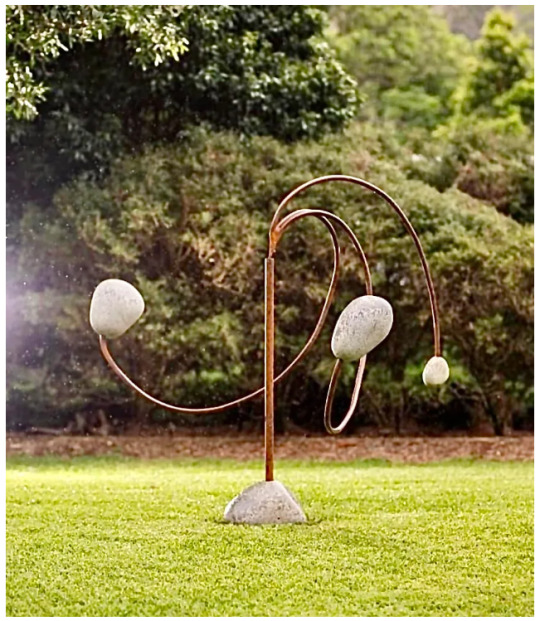
ABOVE | Cossar, F (2021). The Fragility of Fibonacci [steel and stone kinetic sculpture]. https://finncossar.com.au/
This is another example of my friend Finn Cossar's sculptural work. This is a kinetic sculpture that imitates the Fibonacci sequence, the mathematical sequence to nature's biological code. This is an expression of the precarious nature or life, and the delicate balance of the Earth that is home to all life. The kinetic element to the sculpture is a simple rotation, though the curvatures of the steel beams and the delicately balanced stones create a sense of fluid movement. This work particularly is a good base for inspiration with kinetic sculpture as it is an achievable form of movement with a great visual and conceptual base, using minimal amounts of material. I can imagine something of this caliber in site 1 at Barrambin - though at the moment I'm just letting the imagination go wherever.
Fiona Hall

ABOVE | Hall, F (2003-2006). Tender [museum display style installation of bird nests woven with money]. https://learning.qagoma.qld.gov.au/artworks/tender/
I came across Fiona Hall in my first year at Uni, her work is not something I ever would have thought would resonate with me but I found myself drawn to her use of experimental materials and how potent the metaphorical correlations were to her concepts. The site walk reminded me of this particular work Tender (2003-2006). This work is a museum style display, the large glass cabinets contain various man made animal nests intricately woven with shredded American dollar bills. "Hall explores the complex relationship between the natural world and human systems of value, trade and exchange" (QAGOMA, n. d.). Barrambin was a cultural gathering place to trade for Indigenous people, I'm curious to learn more about this as I think it could lead to a conceptually rich work. This work is an example of how trade and exchange may be presented in a naturalistic and metaphorical way rather than a literal way.
0 notes
Text
Artist Interview + Research | Finn Cossar
This is a transcribed interview I conducted over the phone with my primary school friend and now artist Finn Cossar.
How would you best describe your practice?
The best way to describe it is a snowballing kind of scenario where you create one sculpture, and then in the process of creating that sculpture is where you get ideas for the next one. So, it snowballs off each sculpture, it’s kind of like a journey. Ever since I submitted my first one about 4 years ago it’s been like a snowballing thing. Where you get ideas and develop those idea until you eventually have the money to buy the materials and bring them to life.
From what I can see, your work seems to have a strong connection to the environment and nature. What particularly interests you about that and how do you make those connections in your work?
I think a lot of it has to do with the big fact of global warming and environmental messages regarding species or that kind of stuff. That’s usually my thing that I stick with. Once I find a niche pocket that I want to explore into that broad kind of scenario, that’s when I’ll start narrowing down what message it is. I kind of start off creating a sculpture knowing that I want kind of a broad meaning around it, and as I’m making it I’m coming up with different message that are kind of being spoken as it’s being made. It kind of evolves as you make it. The environmental factor is just kind of always there, but it becomes more niche as it comes closer to completion.
Would you say that the materials you use are intentional with the messages you’re trying to get across? Or do you just work with what you have?
Yeah so the materials, they’re always metal because I really like the idea of the sculptures lasting. I always try to make them out of something that’s at least going to live longer than I will. So, it’s like a message that it has more of a voice than I will.
Like a legacy?
Yeah it’s like if you want to spread a message you only have 60 years in good health to do it but if you do it through a sculpture you have it spread for up for 200 years. It’s thinking about it more mechanically I guess.
You mostly work with metal; how do you do that? Do you have a studio?
Um I have a shed. I have a one car garage and basically I have my welder, a big hunk of wood and a hammer and you just bang on the metal until it does what you want it to do. Or you weld bits or cut bits out and melt bits and yeah so that’s kind of the way it goes.
Would you say that’s pretty self-taught?
Yeah it’s all self-taught, I haven’t done any trades. It’s you know, trial and error or as you save up more money over the years you start to buy tools that work better. Like I upgraded my welder, and I was then able to make bigger things.
When you get one of those ideas for the next work, do you make plans for that work (eg. Sketch up?)
It’s starts with the initial concept that’s often just a quick doodle just to get it on paper and I’ll go see my dad and get him to draw it up and then ate least people (instead of me rambling my idea) I can show them a photo of what I’m talking about. And then once it’s a yay or nay, I just start buying metal and get going.
You do it all by hand then?
Oh, there’s some things where if it’s I need to weld aluminium I’ll go get a blacksmith to do it. Or certain materials that you kind of have to buy and shape. So, it’s 90% by hand.
If you have any, what key elements are you thinking of when you make these sculptures (balance, form, movement)?
Yeah I think the key thing I’m thinking of is, it’s existence. So, I’m thinking of over the years how is this going to interact with its nature. Then that opens up a whole new world, where if it’s on the beach are there going to be tornados that are going to rip through in 2 years’ time. It’s very technical thinking and then also you don’t want it to be so technical that it’s boring. There’s also that creative bit where it’s like what will people look at it. I kind of imagine you know seeing it for the first time and what will people reactions be when they first see it, and will they get what I’m talking about or will they think I’m a nutcase. That’s kind of it.
So, you’re a bit of a logistical thinker?
Yeah but not too much, like it needs to be logistical when you’re working with very heavy things because you don’t want to crush people. But you also want it to be you know, creative.
What advice would you give to someone starting out in sculpture or trying out more physical/industrial materials?
Um, just don’t be afraid of anything. Just friggen go ham, go hectic. Make it as big as you want, I know so many people over the years like ‘oh gotta watch the size’ like no, fuck that. Do whatever you want. Make it as big as you want and the rest it will all fall into place. If you have an idea to make a sculpture that’s 1cm high, then that’s friggen awesome. If you want to make on that’s 10m high that’s also cool. Find the materials that really resonate with you and then just throw them together until they look cool.
0 notes
Text
Task 9 | Object + Site

ABOVE | Object + Site
PROCESS
This week I joined a group of two, together we made three. The prose was 'more than human'. My group and I discussed what they had already started making and what their concepts were. I was able to chime in and have my perspective. Together we worked with clay, adding sand to give it a cement like texture. We created a small home like structure, working with mass, volume, negative and positive space, balance and plane.
We installed out work in the workshop, in an area that had a very industrial look. This supported our thoughts about the intersection between the organic and the industrial, the human and the non-human. With the ICB creating a soundscape in the background, our task came together.
DOCUMENTATION




REFLECTION
In reflection, it was great to do group work for the first time this semester. I generally like working alone but it was good to push my boundaries and openly discuss spatial art with other artists. I think working collaboratively will help me expand my horizons with spatial works, as it is a new medium for me.
0 notes
Text
Task 7 | Interval + Repetition

ABOVE | Task 7
PROCESS
We were spoilt for material choice in with this task. I chose paper and string as I hadn't worked with it thus far in the unit. I sat next to this tree and just observed it for a few minutes, I saw the patterns in the paper bark. I had recently come across Alexander Knox work, specifically Light, Liquid, Vapour (2018) which consists of repeated planar cloud shapes which gave an impression of rhythm and movement. I decided to cut the paper into organic shapes the imitated the paper bark patterns of the tree.
I attached the string to the tree as a spine that would attach the paper sequence. I arranged the paper along three paralleled horizontal axis's, the paper creating an irregular repetition. None of the pieces were the same, some were stacked on top of each other and there were some interruptions of the repetition where there was empty space. The paper in terms of materiality has an interesting relationship to the tree having been birthed from it. The tree is the elemental foundation of paper, and we can't revert he process. Paper is not as eco friendly as it seems, here the paper piece flutter in the wind, dually creating a kinetic rhythm as well as visual. The paper appear to be peeling off the trees trunk.
DOCUMENTATION




REFLECTION
In reflection, this week content helped me understand the terminology for visual patterns, repetitions, intervals and rhythms. I was able to test it out using a new material and on a new site that had a direct relationship to the material. This piece would be interesting to develop, perhaps all over the tree but I would need to research the impacts of this and the figure out the logistics of how it would interact with the environment (blow away, get wet etc).
ARTIST RESEARCH


ABOVE | Knox, A. (2018). Light, Liquid, Vapour [metallic cloud sculpture]. https://alexanderknox.com/public-works/light-water-vapour
0 notes
Text
Task 6 | Volume + Proportion + Site II

ABOVE: Iteration 1
PROCESS
I have never used SketchUp before, but my background in Photoshop gave me a good base to start. As this was not entirely self-guided, I followed along with the class, learning about the basics. I first had to get my head around the x and y axis, and importantly object 'stickiness'. For my first iteration I got a bit distracted and made a composite volume out of pyramid and trapezoid like 3D shapes. I was playing around with stickiness at my own pace, grouping objects together, and colour and opacity. I was essentially just trying out the different tools and probably getting ahead of myself. Though it was good to get the cogs ticking with this new digital medium.
The second iteration is more sensible, and more feasible in reality. I got the 'feasibility' part mixed up with this task as the first iteration was meant to be feasible in reality and ruled my gravity. While I mixed it up, I still did both of the proses. The second iteration is comprised on cylindrical volumes emerging from the 2D plane. On top of these formations were more organically shaped cylindrical forms I made with the free form tool. Again I played with colour to give the impression of depth, mass and to create visual contrast to emphasise individual proportions between the forms. These look like they could be whimsically shaped fish tanks.
I tried a third iteration as I wanted to incorporate negative space with an imaginary installation, in an imaginary gallery room. I wanted to make a form that would be all encompassing in real life. I created a box and hollowed it out to create a room. I painted it black, then I punched through a cylindrical form through the roof and painted it pink, and once again but painted orange. This iteration was difficult because I got a bit lost trying to work out how to create hollow forms. I couldn't get it to do what I wanted but it was beneficial to try. My idea would be that a light source would be within the empty cylinder, emanating a warm light through the transparent pink and yellow planes. It would fill the dark room with a nurturing light, I love the feeling of walking into a dark room with a salt lamp on. While my imagination got away from me, I like the mass and form I was able to display through negative space.
DOCUMENTATION

ABOVE: Iteration 1
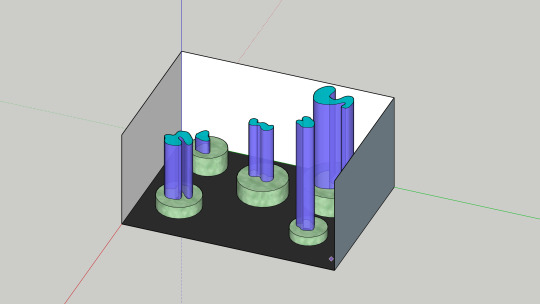
ABOVE: Iteration 2

ABOVE: Iteration 3
REFLECTION
I was able to familiarise myself with the basic SketchUp tools, so I can now continue my work with it at home. I felt I had the hang of it at the start, but when I tried my third iteration I think I got ahead of myself. If I slow down and watch tutorials I may be able to achieve that composition. I struggle to listen in class sometimes, I have a tendency to get distracted and do my own thing and I suspect this may have let me down in learning some key points, and probably why I got the iterations mixed up. I am happy with this task overall in reflection, though I will need to go slower with the next SketchUp tasks to get them right. This will be necessary if I want to try more sculptural visualisations like task 4.
ARTIST RESEARCH
FINN COSSAR

ABOVE: Cossar, F. (2022). Mineral Greed [stone and molten metal sculpture]. https://www.instagram.com/p/CgvUsm5BxFp/
A friend from primary school Finn Cossar, is a currently practicing sculpture artist local to the Sunshine Coast who works with metal and stone. Cossar's work is concerned specifically with global warming and the environment. Mineral greed (2022) is comprised of a stone with a warm light emanating form it's center, imitating the molten center of the Earth where minerals are formed. Spurting out of the stone mass is fluid, organic molten metal that appears to be bursting out of the heat. "This mineral rich stone is at breaking point, spewing out all that it has, both beautiful but unprofitable." (Cossar, 2022). Inside the molten metal are air bubble that create negative volumes within the formation, which is then completed with the positive volumes on the ground, scattered around the focal formations. Cossar's work has a deep connection to the earth through material. The great mass is intimidating, as much as the power the Earth has. I admire the creativity and innovation this piece displays, the proportions of each ingredient have a causal relationship and are uniquely tied together and emphasised with materiality.
ANDY GOLDSWORTHY

ABOVE: Goldsworthy, A. (1991-2003) Floodstones Cairn [stones stacked into a sculpture]. https://artincontext.org/andy-goldsworthy/
Andy Goldsworthy is an artist primarily working with land art but his practice traverses photography, installation and drawing. He also shares a deep connection to nature and the materials it provides up to create with. Goldsworthy's sculptures aren't just in nature but are a part of it. Goldsworthy's site specific work champions the intrinsic beauty of the natural materials he uses, which are nurtured by his organic and peaceful process (Art in Context, 2021). Floodstones Cairn is a great example of Goldsworthy's use of volume and site. The structure is composed of many large stones into a great cone shape, it is created from it's site. The presence of the form is unavoidable. unlike Finn's work that is built to last, Goldsworthy's work is ephemeral and reclaimed by nature over time.
REFERENCES
https://sculptureontheedge.com.au/artists/finn-cossar/
instagram
https://finncossar.com.au/
1 note
·
View note
Text
Task 5 | Volume + Proportion + Site I

ABOVE: Iteration 1 Volume + Proportion I
PROCESS
For this task we had a few options for materials, I tried to think of what materials I resonated with the most. I chose sand and clay, I don't know if I particularly resonate with them but I do like the malleability of clay and the texture of sand. The two are kind of adjacent, earthy substances so they have a close kind of relationship to each other. I decided to stay really simple with this task adn work with two organic volumes so I could explore proportion easily and through different iterations, I had found I wasn't iterating enough o find the best outcome previously.
For my site, I noticed these dark circles on the concrete outside the workshop. I'm not sure what was there to create the shape but I thought it was cool that it was a perfect circle. My first iteration (above) is not a euphemism for a boob. It is however, juxtaposing a flat, circular surface with it's 3D spherical cousin. The clay sphere gives the impression of volume because of the dense materiality and shadow it casts. Rather than contrast a large and a small form, this attempts to show the different proportions of the same mass of different materiality. Proportion and volume is explored through the juxtaposed composition of the two elements.
My second iteration follows a more basic example of proportion by the obvious comparative scale between the two forms. This image reminds me of images of the Earth next to Jupiter, comparing the masses of the two planets. The composition emphasises the different kinds of volumes present; large and flat, dense and compact.
The third iteration attempts to swap the roles of the volumes, the clay sphere has been flattened, accentuating the materials plasticity. The sand is poured into a cone like shape. This iteration was to play around further, it confuses the sense of volume, mass and proportion that was established in the first and second iterations. In all three iterations, the circle stain on the concrete encloses the work, ensuring that the dialogue between the two organic forms is captured.
DOCUMENTATION



ABOVE: Iteration 1


ABOVE: Iteration 2

ABOVE: Iteration 3
REFLECTION
This task was another fun one, I enjoyed playing with clay. It felt like I was making a physical connection to the material by feeling it in my hands. I felt the same effect creating the circle with the sand, spreading it out with my fingers. I felt I gathered more resonance with materials rather than a better understanding of proportion, I wonder if a larger overall scale may have emphasised volume more. I would like to come back to clay later in the unit as I seem to bond with it more than other materials. It's almost like drawing with real matter over pen and paper which is familiar to me.
0 notes
Text
Task 4 | Plane + Site

ABOVE: Ruins at McWhirters (Task 4)
PROCESS
This task was fun, I enjoyed being free to create any wacky, unrealistic sculpture I thought of, especially on a (digitally) larger scale. The plasticity of digital mediums is something I've always enjoyed as you can iterate and refine easily. Though I've never attempted to visualise spatial artworks this way until this unit.
I took photos of the planes of cement in Chauvel Place, I was attracted the the gritty textures and staining. I find myself drawn in by the unique textures, staining and rusting that are a organic causality of the material interacting with environmental elements. After researching Charles Ginnever's work I wanted to visualise something angular and industrial. I like the aesthetic of the film photo from task 2, grain can hide a quick and shoddy photoshop job, as well as give it that timeless aesthetic. This is a photo of my friend taking a photo of my band at the top of McWhirters in the Valley last year. I thought it could be interesting to incorporate a human element into my visualisation, interacting with the imaginary space. I'm interested in 'activating the surrounding space' as I've seen in my artist research. I, as do many other Valley rats love McWhirters, you get the best panoramic view of the city. This is an urban environment which is different to a natural one, however it's my environment where I've had many great memories.
As I multiplied the planes and constructed them in arbitrary ways, I thought they resembled Greek ruins or Stonehenge, just without the historic character. Which poses the question, what are we leaving behind? This is also interesting as it interacts with the cityscape, laden in concrete. The sculpture uses counterweight to balance, and invites the viewer to inspect it from all perspectives, in which case the linear directions of the planes would change even though they are stationary. The sculpture is rigid, stark and almost cold as it is cement. This could have another level of depth entirely if climbing plants were planted around it (figuratively speaking).
DOCUMENTATION







REFLECTION
This task was a fun way to let my imagination take me anywhere, I think my outcome shows an unrealistic sculpture that reflects physical balance, while looking like it may topple over at any second. The planes used also utilises mass and volume which we are looking at in coming weeks. I speculate that this could potentially look more convincing if I knew where the shadows actually would fall, I believe this would be possible in sketch up. I could potentially use sketch-up and photoshop to create a more realistic visualisations in future. In reflection if allowed myself more time for this task it would have been good to see other iterations of the outcome.
0 notes
Text
Task 3 | Plane + Balance

ABOVE: House of Cards (Plane + Balance)
PROCESS
I enjoyed this task. After finding task 2 a headcase, it was good to reset with material play. I found 12 plywood off cuts of the same shape in the recycled materials bin.
When I thought of balance, my mind immediately reverted back to stacking cards when I was a kid. It brings up nostalgia from the suspense of it going up to the frustration when one of your brothers comes and blows it down, but it would all be worth it for the satisfaction of a completed tower. I began practicing stacking the 'cards' on the workshop benches, laying the cardboard planes in between the layers, until I moved out into the courtyard. I used the grooves in the wooden plane to help the structure balance, though this didn't stop the structure from crashing like a Jenga game 400 times.
Eventually I finished the tower, and just as when I was a kid, the 5 minutes it stood tall was a taste of the euphoria I remember. The materials rely on one another, all the individual ply wood 'cards' are a part of a greater whole. The cards balance is dictated by counterweighting, they ride a fine line of imbalance. The cardboard planes create a new ground, gravity can disperse along the plane. A triangle is the most strong form in construction, it is often used in the construction of bridges, so it is an interesting that the structure has the impression of visual stability and yet is entirely precarious.
The 9 smaller triangular shapes residing inside the overall pyramid shape creates positive and negative space. The shadowing multiplies the triangle forms again and gives the impression of depth, noting that it is a 3D object. The vertical symmetry of the structure creates implicit balance even though the pattern is reductive.
I didn't interfere with the materials at all, so I was able to put them back in the materials bin. This was intentional as I try to be more conscious of my materials and waste in my art practice. The task I have named House of Cards was entirely ephemeral and waste free.
DOCUMENTATION






ABOVE: Documentation of my process
REFLECTION
The piece I made reflects the prose plane + balance well, it was successful in terms of waste and and physical and implicit balance. The structure also speaks to pattern and repetition too. I do wonder what other forms I may have come up with if I had tried other iterations? I would like to have explored an asymmetrical, imbalanced and visually precarious composition as I saw in the lecture. While it was fun to get lost in the process, next time I would like to think more about how iteration and site could add dimension to my tasks and build on the weekly content further.
ARTIST RESEARCH
Charles Ginnever

ABOVE: Ginnever, C. (1993). Rashomon [multiple, angular, sculptures]. San Jose ICA, San Jose, California, U.S.A. https://www.flickr.com/photos/sjica/sets/72157632248266220/
Ginnever was an American sculpture artist (b.1931-d.2019) who was best known for his geometric, angular, trapezoid like metal sculptures that challenges the viewer sense of perception, depth and space (Ground for Sculpture, n. d). The sculpture installation above features multiple steel structures, anchored by the ground. The planes are asymmetrical and acutely angular, and balanced in unconventional ways. Rashomon (1993) is based off a movie of the same name where there are 4 different accounts of one scenario. The sculptures are precisely the same but are presented on a different axis, visually imitating the movie plot and speaking of perception. This piece along with the rest of Ginnever's practice informative to my own explorations in spatial art. I would like to play further with balance and angular planes as I generally opt for fluid and organic forms, and further be able to create conceptual connections to 3D forms.
Tobias Putrih

ABOVE: Putrih, T. (2004). Connection [cardboard box sculpture]. GOMA, Brisbane, Queensland, Australia. https://collection.qagoma.qld.gov.au/objects/2616
Multi-disciplinary, Slovenian artist Tobias Putrih works with fundamental materials including cardboard, plywood, styrofoam, and more to create site specific spatial artworks and installations. Putrih's work traverses concepts from modern political and social history which he expresses through construction model like sculptures that echo the Avant Garde Russian Constructivism and Dada movements. Connection (2004) pays homage to Eero Saarinen's Gateway Arch in Missouri as well as the heroic form of the arch which has been used in construction for centuries (Burnett, 2008) However like my task House of Cards, Connection imitates the strongest of formations with ironically precarious materials, referred to as 'artworks haunted by calculated instability' (Filipovic, 2007). The structure, constructed simply from cardboard boxes plays with counterweight, creating a self supporting arch. While the materials is seemingly mundane, it can be easily be reused and given new life. I admire Putrih's use of space and balance, the sculpture has a suspense to it. I saw this in GOMA a few years ago and felt as thought it might topple down at any second. This piece directly relates to my own task in terms of construction forms (arches and triangles) made out of balancing planar materials. Both of my researched artists activate the space around them, this is something I'd like to consider for assessment 2 as I like immersive installation and post minimalist sculpture.
REFRENCES
0 notes
Text
Task 2 | Line + Site

ABOVE | Art>Infrastructure (Task 2)
PROCESS
I found this task difficult and took double the given time frame to settle on a final outcome! I had looked into Gabriel Dawe's installations with string during my artists research on line and direction and thought it would be a sufficient idea to make my own visualisation, multiplying the installations around the photo of the tree in KG (see iterations below in documentation). However, I found out pretty quickly that while I'm pretty deft with Photoshop nowadays, it was going to be almost impossible to edit due to the transparent and complicated nature of the installations.
My contingency was to appropriate Eva Hesse's Rope Piece (1969-1970), my intention was to multiply and scaled up the installation to drape around the tree branches. I abandoned this iteration after an hour, my obstacles being image quality and the fact that there was too much happening visually in the image to distinguish a linear installation.
This got me thinking about the notes I made about what I like in spatial art when I started the unit. BALANCE, MOVEMENT, CONTRAST, GESTALT, FORM, SCALE.
I came across Dutch Lucian Den Arend whose practice based in public and land art, creates geometric and abstract sculptures. Saatchi Art says,
"He involves the observer of the work with the interaction of lines, planes and material. His work owes its significance to this interaction. He uses materials from his surroundings - depending on the location, these can be metal, stone, water, earth or plants; as long as he is in control." (Saatchi Art, n. d)
I found the public sculpture S.A.I.L. (1977) and admired the fluidity that Arend achieved out of an industrial material. I ditched the tree photo, the Uni campus really doesn't mean much to me anyway. I struggle with Uni so the campus leaves me a bit lost for inspiration. I used a photo from my most recent roll of film of the view of the train station and Wesley Hospital from my yard. The area I live in and love has been subject to over development in the last few years, they're turning Auchenflower into Milton and any concern for residents or the old heritage homes in the area is disregarded. My home has been a direct target for development proposals! Brisbane's changing and ever developing landscape is something that does interest me.
I thought what if I put an intrusive sculpture on top of the Wesley that the council would despise? So I arranged duplicates of Arend's sculpture, scaling it accordingly then linking the separate parts together to create a seamless, linear, organic and surrealist looking form. This was an experiment but it does speak to me of over development, so I call this experiment Art>Infrastructure. It uses steel, an industrial material I'm familiar with after living next to a construction site for a year. Yet as Arend intends, the sculpture is entirely its own form, not modelled off any reference. It subtly contrast against the landscape, taking up the view. It conquers the Wesley with in grand scale, the visualisation is now speaks directly to site.
DOCUMENTATION




REFLECTION
This task was frustrating and took some determination to finish, but in the end I came to a conclusion that felt authentic to me, even though it's a sample of another artists work. I typically struggle to connect with a work if it doesn't feel true to me, so these exercises stretch my comfort zone. In future, if I research the site more I should be able to find a meaningful way to connect with it and consequently create work that is unique to that site. I may need to do more research on Chauvel Place to stir some inspiration for the other tasks. I'm curious to experiment more with Photoshop to visualise potential works, the plasticity of digital mediums allows me to try many different conclusions. Though I should try not to get carried away!
1 note
·
View note
Text
Task 1 | Line + Direction

PROCESS
This weeks task was to create a spatial artwork with wire and string/twine only. Firstly I played around with my chosen materials, the smallest gauge of wire and a fine, wispy twine. I wanted to get a feel for the materials physical properties and to see how they interact with each other. In my first iteration of this task I created a simple wire structure by curling the material softly to make a ball like form. I tied the twine to anchor points in the structure without an outcome in mind. This was part of getting know the materials and to get some ideas for what I want I want from my final spatial work for this task.
This got me thinking how the intuitive response to the material would be to attach the string to the wire, so for my second iteration I tried the opposite. I used a bench in Chauvel Place and wove the twine between the wooden planks, making tight, angular lines pointing in a vertical direction. I then loosely molded the wire into organic forms in a horizontal direction, balancing it around the string foundations. Key elements of spatial works I've recognised I am interested in are contrast, negative space, gestalt, and balance. This task led me to focus on contrast of the different materials, and to curate them in a way where their intuitive purposes are switched. Using a bench rendered the bench obsolete, you may as well put a 'wet paint' sign on it. Though rather than paint, you have a spatial artwork exercise that looks more like an inconvenience than an artwork. This was a good way to experiment putting an artwork in a public place and how that effects the space and people around it.
As a little extra play with this task, I iterated a third time, scrunching the wire from my second iteration into a tangled ball with more organic lines. This time I attached the twine in small balls like yarn that would move in any wind or breeze, loosely referencing Newton's cradle. This iteration allowed me to investigate a kinetic form of line and direction.
DOCUMENTATION









REFLECTION
This task was a fun way to start the semester and a great way to get back into the workshop for material play. I enjoyed starting to think about how I may explore and approach a site specific artwork and what key elements I may use, including line and direction. I see similarities with these elements and drawing which is one of my primary mediums. However I'm interested to see how these playout in a physical space. In reflection I will come to the guide workshops so I can see what other students come up with which may inform my own solutions.
ARTIST RESEARCH
EVA HESSE

ABOVE: Hesse, H (1969-1970), Untitled Rope Piece, [Rope installation]. Whitney Museum of American Art, https://whitney.org/collection/works/5551
Eva Hesse was an artist largely associated with the Post Minimalist movement of the 60's until her untimely death in 1970. She was renowned for working with organic and industrial materials in their most basic and unmanipulated forms. Hesse's work allows the physical form to speak for itself, the materiality of her sculptures (that were regularly untitled) evaded the illusionary nature of a painted artwork which was a key diversion of the Minimalist and Post Minimalist movement. The 'ingredients' of Untitled Rope Piece include rope, dipped into latex to create a web like structure. The work is site specific, Hesse's intentions for the work were for it to be malleable. Each installation of the work is hung differently, allowing it to take a different form each time. Hesse wrote, "hung irregularly tying knots as connections really letting it go as it will. Allowing it to determine more of the way it completes its self."
Hesse's work relates to my own experimentation in terms of material, though on a much larger scale. Her material play results in an installation with organic linear directions. My task varies from Hesse's work greatly, however the intention of allowing the work to form itself and the minimal interference with the materials relates to my own experimentation. The material properties are allowed to shine over complicated notions of the fine art world.
CHICHARU SHIOTA

ABOVE: Shiota, C (2021), I Hope [Installation comprised of rope, paper and steel boats]. König Galerie, Berlin, Germany. https://www.chiharu-shiota.com/i-hope
Chicharu Shiota is a currently practicing and exhibiting artist most known for her work with yarn, found materials and everyday objects to create whimsical, immersive installations. Shiota is currently exhibiting The Soul Trembles at GOMA in Brisbane, QLD. Shiota's current body of work is conceptually tied to memory and the existence of life and death. Through her installations she creates dreamlike phycological landscapes that are shrouded in enigmatic metaphors.
Shiota's career began with painting, however the artist had an artistic crisis and began as she explains it, 'drawing with yarn'. Her practice became a form of three dimensional drawing in a physical space. Shiota's work I Hope is a great example of linear direction and movement in a physical space. The yarn cascades like rain over the wire boats creating a falling sensation with it's vertical linear direction, and yet the sheets of red paper appear suspended in movement, a fleeting moment captured. Shiota's work is obviously far more developed than my simple task, though I relate to how she describes the use of yarn as 'drawing in space' and how she translates her 2D practice into a 3D space. I find this influential as I begin to brainstorm how my work will correlate into eco materials and sculpture.
1 note
·
View note